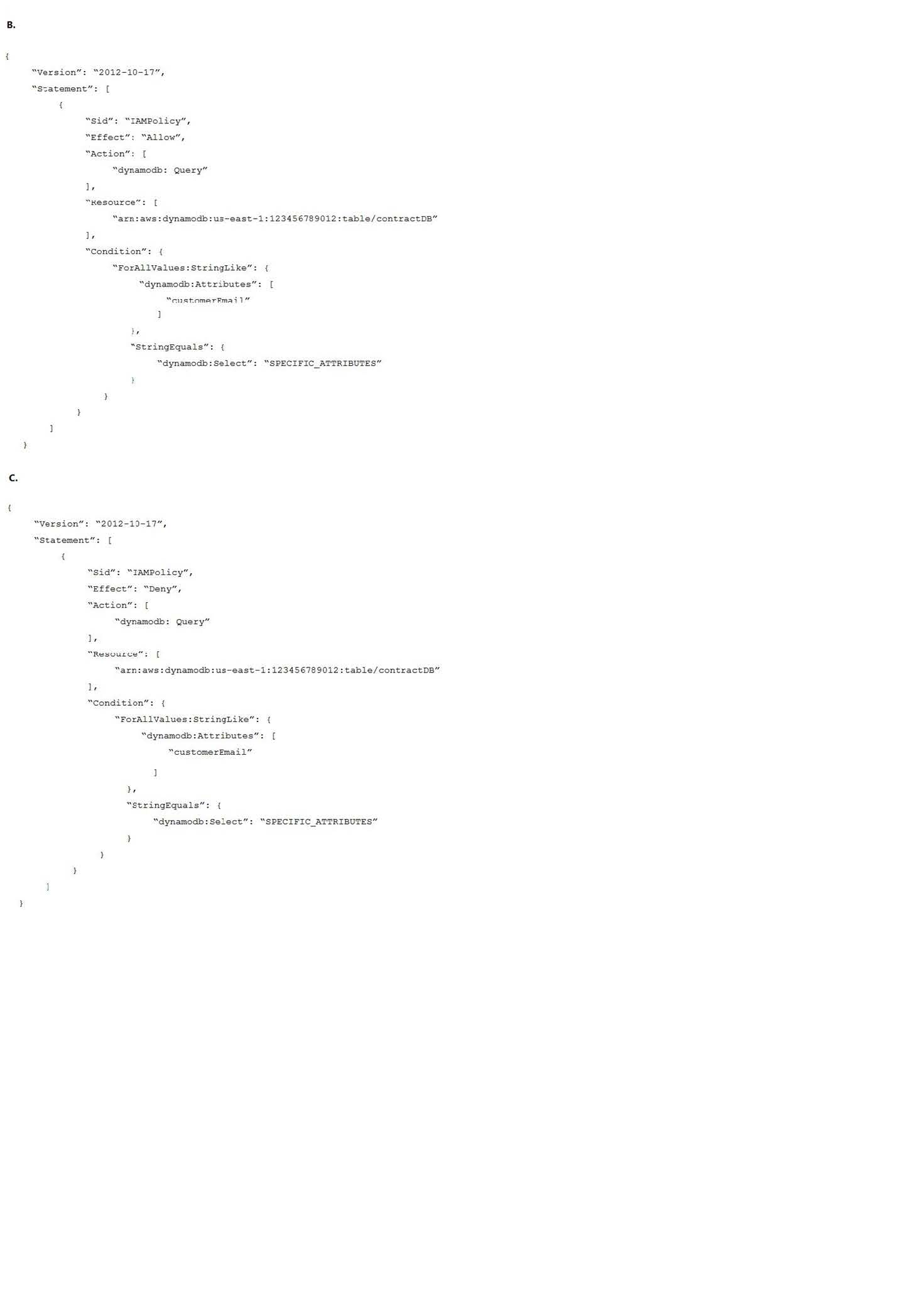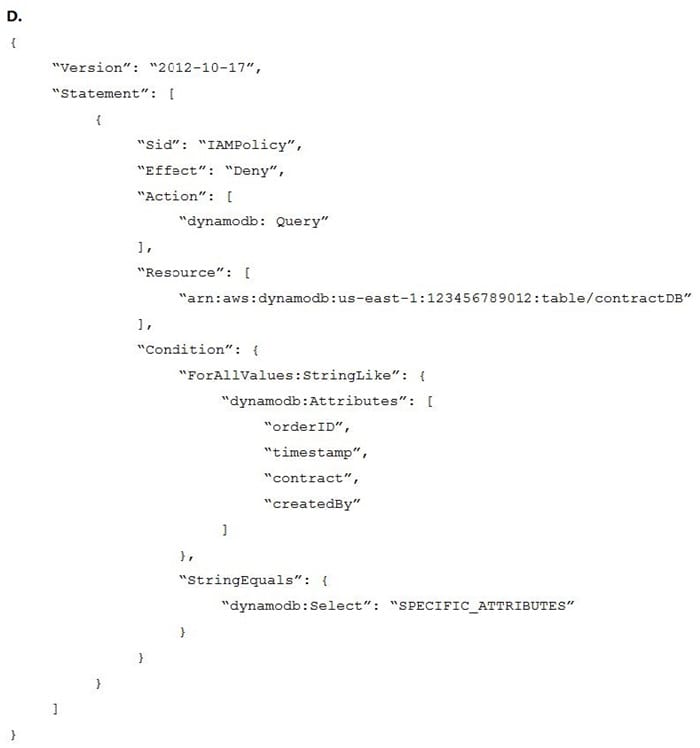Exam Details
Exam Code
:DBS-C01Exam Name
:AWS Certified Database - Specialty (DBS-C01)Certification
:Amazon CertificationsVendor
:AmazonTotal Questions
:321 Q&AsLast Updated
:Apr 22, 2025
Amazon Amazon Certifications DBS-C01 Questions & Answers
-
Question 31:
A company wants to automate the creation of secure test databases with random credentials to be stored safely for later use. The credentials should have sufficient information about each test database to initiate a connection and perform automated credential rotations. The credentials should not be logged or stored anywhere in an unencrypted form.
Which steps should a Database Specialist take to meet these requirements using an AWS CloudFormation template?
A. Create the database with the MasterUserName and MasterUserPassword properties set to the default values. Then, create the secret with the user name and password set to the same default values. Add a Secret Target Attachment resource with the SecretId and TargetId properties set to the Amazon Resource Names (ARNs) of the secret and the database. Finally, update the secret's password value with a randomly generated string set by the GenerateSecretString property.
B. Add a Mapping property from the database Amazon Resource Name (ARN) to the secret ARN. Then, create the secret with a chosen user name and a randomly generated password set by the GenerateSecretString property. Add the database with the MasterUserName and MasterUserPassword properties set to the user name of the secret.
C. Add a resource of type AWS::SecretsManager::Secret and specify the GenerateSecretString property. Then, define the database user name in the SecureStringTemplate template. Create a resource for the database and reference the secret string for the MasterUserName and MasterUserPassword properties. Then, add a resource of type AWS::SecretsManagerSecretTargetAttachment with the SecretId and TargetId properties set to the Amazon Resource Names (ARNs) of the secret and the database.
D. Create the secret with a chosen user name and a randomly generated password set by the GenerateSecretString property. Add an SecretTargetAttachment resource with the SecretId property set to the Amazon Resource Name (ARN) of the secret and the TargetId property set to a parameter value matching the desired database ARN. Then, create a database with the MasterUserName and MasterUserPassword properties set to the previously created values in the secret.
-
Question 32:
A company has more than 100 AWS accounts that need Amazon RDS instances. The company wants to build an automated solution to deploy the RDS instances with specific compliance parameters. The data does not need to be replicated. The company needs to create the databases within 1 day.
Which solution will meet these requirements in the MOST operationally efficient way?
A. Create RDS resources by using AWS CloudFormation. Share the CloudFormation template with each account.
B. Create an RDS snapshot. Share the snapshot With each account Deploy the snapshot into each account
C. use AWS CloudFormation to create RDS instances in each account. Run AWS Database Migration Service (AWS DMS) replication to each ot the created instances.
D. Create a script by using the AWS CLI to copy the ROS instance into the other accounts from a template account.
-
Question 33:
A company is developing a new web application. An AWS CloudFormation template was created as a part of the build process.
Recently, a change was made to an AWS::RDS::DBInstance resource in the template. The CharacterSetName property was changed to allow the application to process international text. A change set was generated using the new template, which indicated that the existing DB instance should be replaced during an upgrade.
What should a database specialist do to prevent data loss during the stack upgrade?
A. Create a snapshot of the DB instance. Modify the template to add the DBSnapshotIdentifier property with the ID of the DB snapshot. Update the stack.
B. Modify the stack policy using the aws cloudformation update-stack command and the set-stack-policy command, then make the DB resource protected.
C. Create a snapshot of the DB instance. Update the stack. Restore the database to a new instance.
D. Deactivate any applications that are using the DB instance. Create a snapshot of the DB instance. Modify the template to add the DBSnapshotIdentifier property with the ID of the DB snapshot. Update the stack and reactivate the applications.
-
Question 34:
A Database Specialist has migrated an on-premises Oracle database to Amazon Aurora PostgreSQL. The schema and the data have been migrated successfully. The on-premises database server was also being used to run database maintenance cron jobs written in Python to perform tasks including data purging and generating data exports. The logs for these jobs show that, most of the time, the jobs completed within 5 minutes, but a few jobs took up to 10 minutes to complete. These maintenance jobs need to be set up for Aurora PostgreSQL.
How can the Database Specialist schedule these jobs so the setup requires minimal maintenance and provides high availability?
A. Create cron jobs on an Amazon EC2 instance to run the maintenance jobs following the required schedule.
B. Connect to the Aurora host and create cron jobs to run the maintenance jobs following the required schedule.
C. Create AWS Lambda functions to run the maintenance jobs and schedule them with Amazon CloudWatch Events.
D. Create the maintenance job using the Amazon CloudWatch job scheduling plugin.
-
Question 35:
A company migrated one of its business-critical database workloads to an Amazon Aurora Multi-AZ DB cluster. The company requires a very low RTO and needs to improve the application recovery time after database failovers.
Which approach meets these requirements?
A. Set the max_connections parameter to 16,000 in the instance-level parameter group.
B. Modify the client connection timeout to 300 seconds.
C. Create an Amazon RDS Proxy database proxy and update client connections to point to the proxy endpoint.
D. Enable the query cache at the instance level.
-
Question 36:
A database specialist is launching a test graph database using Amazon Neptune for the first time. The database specialist needs to insert millions of rows of test observations from a .csv file that is stored in Amazon S3. The database specialist has been using a series of API calls to upload the data to the Neptune DB instance.
Which combination of steps would allow the database specialist to upload the data faster? (Choose three.)
A. Ensure Amazon Cognito returns the proper AWS STS tokens to authenticate the Neptune DB instance to the S3 bucket hosting the CSV file.
B. Ensure the vertices and edges are specified in different .csv files with proper header column formatting.
C. Use AWS DMS to move data from Amazon S3 to the Neptune Loader.
D. Curl the S3 URI while inside the Neptune DB instance and then run the addVertex or addEdge commands.
E. Ensure an IAM role for the Neptune DB instance is configured with the appropriate permissions to allow access to the file in the S3 bucket.
F. Create an S3 VPC endpoint and issue an HTTP POST to the database's loader endpoint.
-
Question 37:
A company uses the Amazon DynamoDB table contractDB in us-east-1 for its contract system with the following schema:
orderID (primary key) timestamp (sort key) contract (map) createdBy (string) customerEmail (string)
After a problem in production, the operations team has asked a database specialist to provide an IAM policy to read items from the database to debug the application. In addition, the developer is not allowed to access the value of the customerEmail field to stay compliant.
Which IAM policy should the database specialist use to achieve these requirements?



A. Option A
B. Option B
C. Option C
D. Option D
-
Question 38:
A social media company recently launched a new feature that gives users the ability to share live feeds of their daily activities with their followers. The company has an Amazon RDS for MySOL DB instance that stores data about follower engagement After the new feature launched, the company noticed high CPU utilization and high database latency during reads and writes. The company wants to implement a solution that will identify the source of the high CPU utilization.
Which solution will meet these requirements with the LEAST administrative oversight?
A. Use Amazon DevOps Guru insights_
B. Use AWS CloudTrail
C. Use Amazon CloudWatch Logs
D. Use Amazon Aurora Database Activity Streams
-
Question 39:
A company is load testing its three-tier production web application deployed with an AWS CloudFormation template on AWS. The Application team is making changes to deploy additional Amazon EC2 and AWS Lambda resources to expand the load testing capacity. A Database Specialist wants to ensure that the changes made by the Application team will not change the Amazon RDS database resources already deployed.
Which combination of steps would allow the Database Specialist to accomplish this? (Choose two.)
A. Review the stack drift before modifying the template
B. Create and review a change set before applying it
C. Export the database resources as stack outputs
D. Define the database resources in a nested stack
E. Set a stack policy for the database resources
-
Question 40:
A financial services company is using AWS Database Migration Service (AWS OMS) to migrate Its databases from on-premises to AWS. A database administrator is working on replicating a database to AWS from on-premises using full load and change data capture (CDC). During the CDC replication, the database administrator observed that the target latency was high and slowly increasing.
What could be the root causes for this high target latency? (Select TWO.)
A. There was ongoing maintenance on the replication instance
B. The source endpoint was changed by modifyng the task
C. Loopback changes had affected the source and target instances-
D. There was no primary key or index in the target database.
E. There were resource bottlenecks in the replication instance
Related Exams:
AIF-C01
Amazon AWS Certified AI Practitioner (AIF-C01)ANS-C00
AWS Certified Advanced Networking - Specialty (ANS-C00)ANS-C01
AWS Certified Advanced Networking - Specialty (ANS-C01)AXS-C01
AWS Certified Alexa Skill Builder - Specialty (AXS-C01)BDS-C00
AWS Certified Big Data - Speciality (BDS-C00)CLF-C02
AWS Certified Cloud Practitioner (CLF-C02)DAS-C01
AWS Certified Data Analytics - Specialty (DAS-C01)DATA-ENGINEER-ASSOCIATE
AWS Certified Data Engineer - Associate (DEA-C01)DBS-C01
AWS Certified Database - Specialty (DBS-C01)DOP-C02
AWS Certified DevOps Engineer - Professional (DOP-C02)
Tips on How to Prepare for the Exams
Nowadays, the certification exams become more and more important and required by more and more enterprises when applying for a job. But how to prepare for the exam effectively? How to prepare for the exam in a short time with less efforts? How to get a ideal result and how to find the most reliable resources? Here on Vcedump.com, you will find all the answers. Vcedump.com provide not only Amazon exam questions, answers and explanations but also complete assistance on your exam preparation and certification application. If you are confused on your DBS-C01 exam preparations and Amazon certification application, do not hesitate to visit our Vcedump.com to find your solutions here.